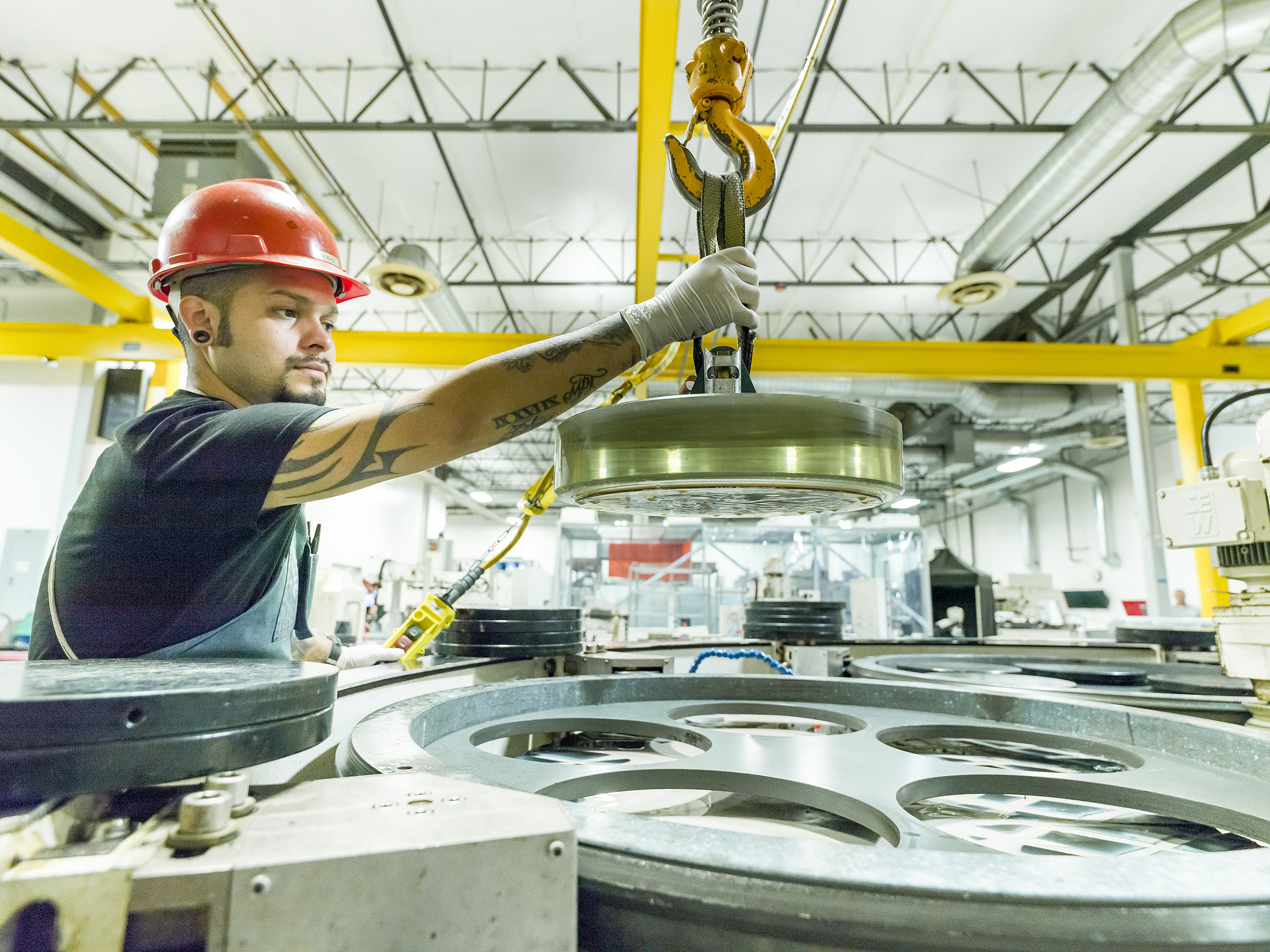Manufacturing
From manufacturing, to assembly and testing, II-VI Aerospace & Defense collaborates with your product development team from initial concept through prototype development all the way to full-scale production to deliver comprehensive turnkey solutions. II-VI Aerospace & Defense has developed many state-of-the-art processes to optimize dimensional accuracy, optical surface figure and mechanical stability of diamond turned substrates. We have pioneered many of the major advances in diamond turned optical components and assemblies.
II-VI Aerospace & Defense assembles and tests all types of optical and electro-optical assemblies and sub-assemblies with challenging specifications including electronic integration. II-VI Aerospace & Defense is well known for producing high performance window assemblies, some quite large, which typically include distortion free bonding, EMI grids, heater blankets, electrical connectivity directly to the window via wires or adhesives, and integration with various sensors.
Among our full range of precision manufacturing solutions, we offer a computer-controlled deterministic polishing process to fabricate high precision aspheric components. We have the advanced technologies needed to produce very steep aspheric components in a wide variety of materials. Combining this with our high-precision metrology, allows us to achieve superb results for virtually every application.

| Concurrent Engineering | Prototype Verification |
| Product Qualification | Production Readiness |
| Production Cell Design | Lean Manufacturing |
II-VI Aerospace & Defense is a leading manufacturer of visible and IR optical components. Manufacturing processes include: CNC milling, spherical generating, fine grinding, CNC spherical and aspheric polishing, edging, and single point diamond turning. The techniques used for these operations range from high-speed automated production to meticulous hand finishing by master opticians.
| Telescope Assemblies | Polygons and Fold Mirrors |
| Diffractive and Fresnel Optics | Aspheric, Toroidal and Off-Axis Shapes |
| IR Lens Assemblies | Axicons and Waxicons |
Over the past several years, our diamond turned products have seen an exponential growth in demand for many applications. These include: missile warning optical systems, IR sensing systems for Homeland Security, infrared search and track systems, a broad range of transmissive IR optics and systems, snap-together telescope designs, numerous reflective TMA telescopes and focal plane array back thinning.
Aspheric & High Complex Components
II-VI Aerospace & Defense entered the complex aspheric components manufacturing market several years ago as a production enabler for some of the world’s most sophisticated telescope assemblies.
Among our full range of precision manufacturing solutions, we offer a computer-controlled deterministic polishing process to fabricate high precision aspheric components. We have the advanced technologies needed to produce very steep aspheric components in a wide variety of materials. Combining this with our high-precision metrology, allows us to achieve high quality results for virtually every application.


Assembly Technology
II-VI Aerospace & Defense' Assembly area is equipped to provide simple to complex opto-mechanical and opto-electronic assemblies. The Assembly group builds assemblies to established engineering drawings as well as refining current optical designs to reduce cost and/or improve performance. With over 100 years of combined hands-on experience, II-VI Aerospace & Defense can also design and test precision optical assemblies based on your concept. Realization of assembled products is accomplished through leveraging manufacturable solutions by establishing realistic component and sub-assembly specifications and by carefully considered design of specialized alignment tooling. In-house testing capabilities include interferometric, spectrophotometric and light polarization measurement as well as mechanical, electrical, environmental and laser damage testing. II-VI Aerospace & Defense currently has 4,000 square feet of class 1,000 work stations located throughout the class 10,000 assembly area dedicated to current and future manufacturing of optical assemblies.
Bonding Technology
II-VI Aerospace & Defense is proficient in various types of optic-to-optic bonding methods including optical contacting, UV cure bonds, and chemically activated bonds. Optic-to-metal bonding processes utilize MIL-SPEC adhesives, sealants and potting materials as well as soldering of optical components into housings to form a hermetic seal or to facilitate efficient heat transfer.
II-VI Aerospace & Defense utilizes a proprietary chemically-activated bonding method referred to as the V-LOCK bonding process. The advantage of this process over traditional methods is in it’s ability to provide superior bonding of both similar, and a multitude of dissimilar, glass and crystal materials.
II-VI Aerospace & Defense will employ optimum bonding methods, depending on your application.
Precision Assembly & Alignment
II-VI Aerospace & Defense' assembly area utilizes the latest techniques in lean manufacturing. U-shaped work cells in modular and reconfigurable work areas are used to efficiently manufacture precision optical assemblies. This assembly area also makes use of automated electrical and environmental test chambers, high tech lens alignment tools, and in-situ optical testing at 0.633, 3.4, and 10.6 micron wavelengths.
II-VI Aerospace & Defense assembles and tests all types of optical and electro-optical assemblies and sub-assemblies with challenging specifications including electronic integration. II-VI Aerospace & Defense is well known for producing high performance window assemblies, some quite large, which typically include distortion free bonding, EMI grids, heater blankets, electrical connectivity directly to the window via wires or adhesives, and integration with various sensors.
II-VI Aerospace & Defense offers a series of F/1 long wave infra-red (LWIR) fixed focus objectives with fine adjustment operating in the 8-14 μm spectral region. These LWIR objectives are manufactured for high optical performance with an easily adjustable focus. A wide range of standard field-of-views are provided for various applications. II-VI Aerospace & Defense also provides customized LWIR objectives engineered and built to customer requirements. Optional camera integrations are available upon request.
Testing
II-VI Aerospace & Defense is committed to producing the highest quality products for our customers. Our goal is to ensure customer expectations are met or exceeded in everything we do, every day, in every element of our business.
II-VI Aerospace & Defense is registered in quality standards AS9100D and ISO9001:2015 through SAI Global. II-VI Aerospace & Defense' compliance to these quality standards requirements helps to ensure that customers will consistently receive the highest quality products.
Testing and inspection is conducted at every phase of the production process to ensure full compliance with customer specifications. At II-VI A&D, our products are frequently tested under the environmental conditions in which they will be used. This includes humidity, temperature, rain and sand erosion, salt fog, salt-water submersion, shock and vibration testing.
Our testing capabilities and equipment include visible and IR interferometers to measure surface form and/or transmitted wavefront; a white light interferometer to measure surface roughness (non-contact); visible and IR spectrophotometers to measure optical transmission and reflectivity; a Dektac surface profiler to measure coating thickness; various environmental test chambers (humidity, temperature and salt spray/fog) a Form Talysurf profilometer; holographic measuring capability for diamond turned aspheric surfaces; and a coordinate measurement machine (CMM).
Strategy
- Provide quality through planning, control, improvement and shared experience
- Focus on rigorous, unrelenting discipline throughout the entire
engineering process - Emphasize total customer satisfaction
- Develop common initiatives, and drive for continuous improvement
- Optimize supplier and product quality through early development participation
- Eliminate defects through process control, product robustness, operator involvement and error prevention
Values and Beliefs
- Total customer satisfaction
- Outstanding customer service
- Innovation, quality and value
- Creativity and teamwork
- Proactive involvement by all team members
For evaluation of the laser durability of materials and thin films, II-VI Optical Systems uses its own designed and operated laser damage test bench. The bench employs a 20Hz laser system operating in a nanosecond pulse regime, with the central wavelength being at 1064nm. The beam delivery system has a wide range of tuning capability with fluence levels exceeding material cohesion strength. This allows II-VI Optical Systems to derive data in accordance with ISO 21254 standard for both laser damage threshold and laser damage certification.
II-VI Optical Systems owns a dual-configuration PCI system. The dual-configuration means that the system can be used for absorption evaluation with the angle between the probe (632.8nm) and the pump (1064nm) beams being chosen between two preset values. The two angles provide the capability for absorption scanning of optics /crystals having different cross-section-to-length aspect ratios. The system is used for production and R&D evaluation of thermal effects of absorption in glasses, crystals, and thin films.
The bench developed at II-VI Optical Systems is used for the laser evaluation of reflective and transmissive characteristics of the part under test. The laser sources (currently available lines are 594nm, 632.8nm, 808nm, 1064nm), the optics, and the mounting hardware have sufficient adjustment flexibility (positional and functional) to permit the operator to evaluate spectral performance of the parts under test against the coating specifications listed on the relevant documentation (e.g. on a customer print or a II-VI Optical Systems print). This includes the capability for varying the angles of incidence. With minor or no modifications, the bench can be (is) used for evaluation of optical density and extinction.
Measurements are performed using a dual-wavelength LossPro system. The system employs the so-called cavity ringdown technique (CRD). CRD is a known spectroscopic technique for sensitive quantitative measurements. It involves measuring decays of laser light in an optical resonator (cavity) consisting of two or more mirrors. With a selectable laser source (1053nm and 1064nm) and a custom-designed cavity configuration, II-VI Optical Systems can test 12 possible scenarios (2 wavelengths, two input polarizations: s- and p-, three angles of incidence: 0°, 30°, and 45°) in linear and V-cavity configurations. The system is used regularly for evaluation of highly reflective mirrors where total losses do not exceed 1000ppm (i.e. 0.1%).
II-VI Optical Systems has several test beds for evaluating extinction at 632.8nm and 1064nm. The main differences are in the geometry/product that is evaluated at each of them. Some test setups are customized for extinction measurements at non-zero angles of incidence.
For the evaluation of product resistance to environmental conditions, II-VI Optical Systems uses temperature, humidity and salt-spray/fog chambers. This allows II-VI Optical Systems to derive data in accordance with the requirements for environmental and durability testing, as specified in Military standards MIL-C-675, MIL-M-13508, MIL-PRF-13830, MIL-C-48497 and MIL-F-48616.
